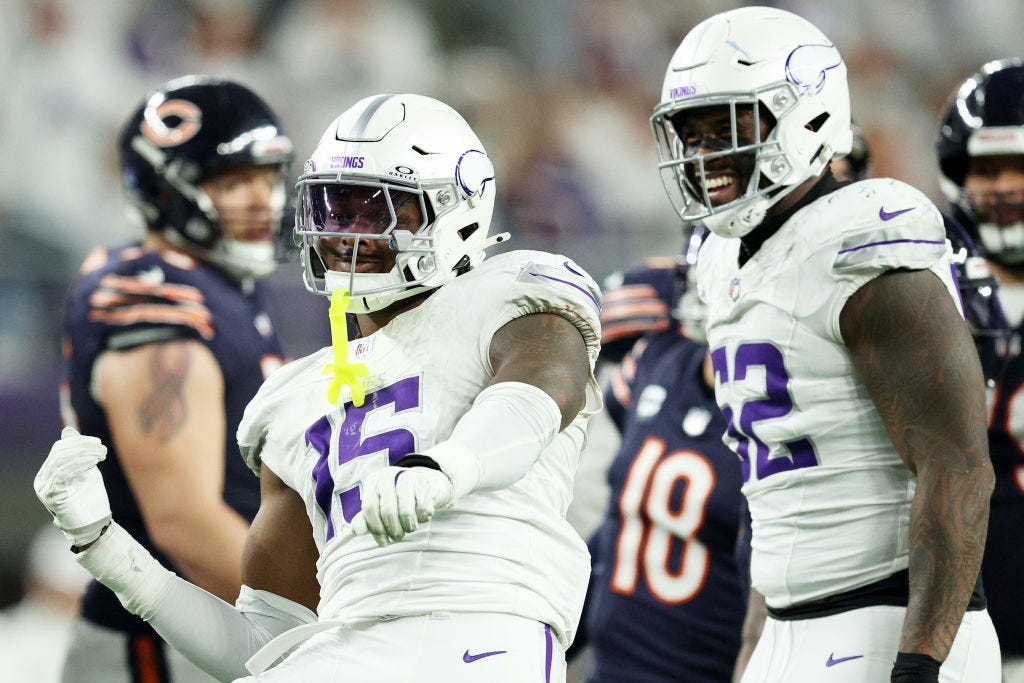Luke Braun's Film Room: Is the Panic on Dallas Turner Justified?
Much has been made of first-round pick edge rusher Dallas Turner's slow start. Is there reason to be concerned? Luke Braun digs in.
Back in October, it felt like the sky was falling for the Vikings. Amidst doom and gloom over a two-game losing streak and Christian Darrisaw’s season-ending injury, concerns grew over Dallas Turner. He had played just five snaps in their loss to Detroit and just three in their Thursday night loss to Los Angeles.
Even when he did get on the field, he was a statistical non-factor. No flashes. He had one sack in week one, then didn’t have a solo tackle for four games, and seemingly got benched for Jihad Ward. Is he a bust? Have the Vikings already given up on a player they traded so much to draft?
Of course, less than halfway through a rookie’s first year is far too early to declare success or failure. But it’s not too early to evaluate. If we’re going to do that, however, we need to look deeper than snap counts. It’s not enough to simply draw a conclusion based on how often Turner was on the field.
Turner’s snap counts have dominated the discourse so far. You might see some mention of pressure count, but I’ve found myself dissatisfied with the level of detail available for these statistics.
After all, if Dallas Turner isn’t playing a lot, it’s only natural to ask why. It’s perhaps even more natural to assume the answer: that he’s playing poorly. But is poor play responsible? Is it just a factor of Jonathan Greeanard and Andrew Van Ginkel having Pro Bowl seasons?
Even if we assume he’s struggling, which we shouldn’t, we can be more curious and ask why. Is he struggling mentally? Physically? Are these struggles going to continue, or can we chalk them up to the rookie learning curve?
Over the last three weeks, I’ve made three separate videos reviewing Dallas Turner’s performances in those respective games. Two are free to watch, and the last will be made free at the conclusion of Minnesota’s December 22nd contest in Seattle.
I’ve learned a lot about Dallas Turner in this process, but these videos came out week by week. That means I haven’t stopped to pull all of these disorganized insights together and examine the trends. That’s what this article is for.
The Two Sides Of Run Defense
Outside linebackers like Turner, see their job change a lot depending on whether they’re on the front side or the back side of a run. Both are all about spacing. The offense wants to create spacious rushing lanes. The defense wants to deny them. That often turns into a contest of power.
Dallas Turner is 6’4” and weighs 247 pounds. That puts him in the 9th percentile of all edge rushers in the Mockdraftable database. To win these situations, he has to beat players who just have more weight behind their hits. He has to win with leverage and technique where he can not win with power alone. Welcome to the NFL.
What Can We Learn About Dallas Turner?
The Minnesota Vikings traded up from pick 23 to pick 17 to draft Dallas Turner, an edge defender from Alabama that many believe may have been the best defensive player in the draft.
Offenses want to take advantage of this on run plays, whether they are zone or gap. Both of them try to take a guy like Turner and widen him out. Here’s a zone run from Atlanta that goes exactly how they want it to.
Getting pushed around by Drake London and Jake Woerner isn’t ideal, but we have to be sure to learn the right lesson. This failure isn’t just on Turner’s weight or strength, it’s about angles. When Woerner makes contact, Turner’s hips are angled to the outside, giving Woerner all the leverage in the world.
Keep reading with a 7-day free trial
Subscribe to Wide Left to keep reading this post and get 7 days of free access to the full post archives.





